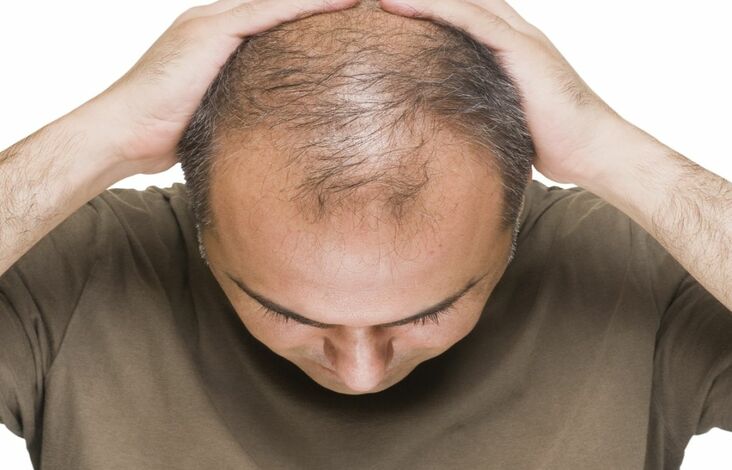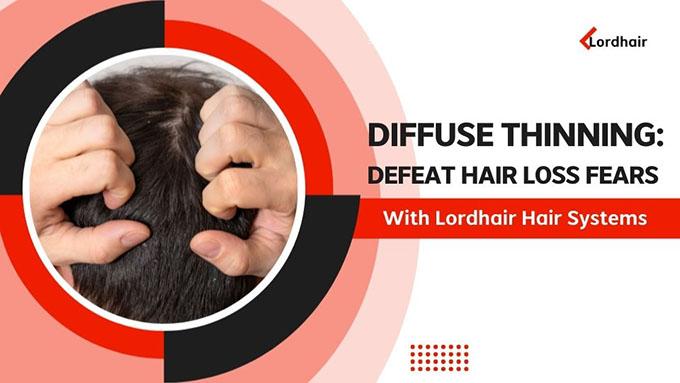DHT Hair Loss: Meaning, Causes, Symptoms, and Treatments
- Written by Victor Lordhair
- | Published May 23, 2022
- |
- 4 min read
 Listen to the full text
Listen to the full textUndergoing chemotherapy, losing weight quickly, taking certain medicines, and encountering a serious illness - there are a lot of reasons behind hair loss in men and women. But DHT is rarely mentioned as a hair loss factor even though 30 million women and 50 million men in the US alone face this type of hair loss. Now you must be wondering, “what exactly is DHT hair loss? What triggers it and what are its symptoms? How can we treat DHT hair loss?”
That’s a lot of questions and in this blog, Lordhair will try to answer all the important ones. From meaning to symptoms and causes to treatments, we will cover everything about DHT hair loss.
Let’s learn its meaning first!
What is DHT?
DHT, better known as Dihydrotestosterone, is a hormone that is produced from testosterone present in the testes, the prostate, and certain tissues. Almost 10% of testosterone produced by an adult every day is converted to dihydrotestosterone.
Scientists say that DHT, when compared to testosterone, is more powerful and is essential for most hair growth. In fact, changes triggered in the human body by testosterone actually take place only after it is converted into DHT.
Apart from hair growth, DHT is also responsible for prostate growth and sebaceous gland activity.

How Does DHT Cause Hair Loss?
Even though DHT is critical for several core body functions, it can also cause hair loss in men and women. Human hair within a follicle usually goes through three stages of the growth cycle - anagen, catagen, and telogen. In the first phase, the cells in the root of the hair keep dividing rapidly. In other words, a new hair is formed and it pushes the strip hair off the follicle and ultimately out.
In the catagen phase, the growth of new hair stops and its outer root sheath shrivels and attaches to the root of the hair. Hair follicles in the telogen phase become standstill and new hair replaces them. One will see a solid, hard, and dry bulb-like white material at the tip of the hair falling during this stage.
In DHT hair loss, hair follicles shift from the anagen phase to the telogen phase sooner than usual. According to dermatologists, once DHT begins to flow freely through the bloodstream, it links itself to receptors on hair follicles in the human scalp.
As a result, it shrinks hair follicles as well as shortens the life cycle, causing hair to grow out looking thinner and brittle. DHT hair loss makes hair follicles incapable of delivering a healthy head of hair.
What are the Symptoms of DHT Hair Loss?
The following are known signs and symptoms of DHT hair loss in men and women:
Acne: High levels of Dihydrotestosterone (DHT) sends the sebaceous glands into a frenzy. It causes the skin to produce more sebum and results in high levels of androgens. Boosted oil production and clogged pores cause acne on the face, scalp, and other parts of the body.
Receding hairline: This is one of the most well-known symptoms of DHT hair loss. Variations in the androgen receptor (AR) gene can make some men and women more vulnerable to side effects of DHT. It causes hair at the front to recede and form an M pattern in males.
Although hairline doesn’t recede in a specific pattern in females, they will notice a slow, progressive loss of hair and scarring of the scalp near the forehead.
Hair loss at temple and crown: Another known sign of DHT hair loss, men and women with a receding hairline may also witness hair loss at the temples and crown of the head. With the passing time, they notice a horseshoe pattern of hair loss around the sides and top of the head.

What are Treatments for DHT Hair Loss?
DHT is an essential part of the human body. This means that getting rid of it is not practical. However, you can stop your DHT hair loss condition from getting worse by lowering its level.
There are some treatments and lifestyle measures that can help men and women address symptoms of DHT hair loss and prevent irreversible hair damage. Here are some of those:
#1 Finasteride
Finasteride is a 5-alpha reductase inhibitor that can help an individual address hair loss caused by DHT. An oral, prescription-only medication, it binds to 5-AR proteins to block DHT from binding itself to receptors on your hair follicles and prevents them from shrinking.
This oral medication can promote scalp hair growth and prevents pattern hair loss caused in men only. Because of the potential risk of teratogenicity in a male fetus, women - especially those who are pregnant - are highly advised to keep away from Finasteride.
Apart from helping men prevent damage caused by DHT hair loss, Finasteride also has its share of side effects. Some known side effects are:
- Impotence
- Loss of interest in sex
- Swelling of hands or feet
- Dizziness
- Weakness
Check out all the major side effects of finasteride.
#2 Minoxidil
We bet you have heard about this medication for DHT hair loss. Unlike finasteride, minoxidil can be used by both men and women. While it doesn’t prevent hair loss, it helps shorten the telogen (resting phase) of the hair growth cycle and moves strands into the anagen phase.
Also called Rogaine, Minoxidil is available in oral and topical (for scalp) forms and can be used as a 2% and 5% solution. We highly suggest getting a prescription from a dermatologist before using it for DHT hair loss as it also has negative effects on the scalp.
Here are some known side effects of Minoxidil:
- Scalp irritation
- Eczema
- Abnormal hair growth
- Allergic contact dermatitis
- Redness
- Burning
- Respiratory infections
Learn more about the minoxidil side effects.
#3 Wigs
Unlike finasteride and minoxidil, wigs don’t have any side effects. They are designed using real human hair hand-woven onto a base made of premium skin-friendly materials. Also known by the name hair toupees for men and wigs for women, wigs completely cover the part of your head affected by DHT hair loss.
Wigs for men and women create a fabulous fullness from the crown to the back. Attached using clips, tape, or glue, they are made of 100% human hair and blend easily with real hair to deliver a hyper-realistic look.
And that’s not it! This non-surgical hair recovery solution comes with many benefits for men and women with pattern baldness on the head or massive overall thinning caused by DHT. Here are some of them:
- Delivers instant results
- Can be attached quickly
- Highly cost-effective
- Semi-permanent with regard to attachment. Meaning, you don't take it off everyday - it stays on whilst you sleep and shower
- Comfortable, breathable, and durable
Check out how awesome Juha looks after wearing Lordhair’s premium hair toupee:
#4 Lifestyle adjustments
Practicing a healthy lifestyle can also help men and women reduce DHT levels naturally. Losing weight can slow down DHT production; so does working out regularly, no smoking and drinking, sleeping for optimal hours, and doing yoga and scalp exercises. These lifestyle adjustments can help reduce stress and increase blood flow.
#5 DHT blockers
Apart from the aforementioned oral medications, men and women can also consider topical medications for DHT blocking. They can also give DHT blocker shampoos or DHT blocker supplements a whirl. However, use these over-the-counter medicines only after being sure that DHT is the main cause of your hair loss.
If something else is brewing, then, you might escalate damage. So, consult your doctor before getting on anything.

DHT Hair Loss Recovery
Above are some treatments for addressing DHT hair loss in men and women. Keep in mind that DHT is a major reason for pattern hair loss and receding hairline in men. It's also linked with natural genetic predisposition as well as processes that result in hair fall in mature years. The sooner you address DHT hair loss, the farther you will remain from irreversible damage. Speak to a dermatologist if nothing works well for you.
Got any queries to ask? Send them to support@lordhair.com and have them answered by our hair experts.
Also read:
Hairpieces for alopecia to get rid of baldness
The connection between kefir and hair growth
Types of wigs caps to consider for the next purchase



